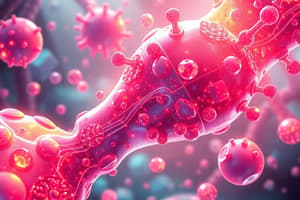Podcast
Questions and Answers
A drug is administered orally and undergoes significant first-pass metabolism. How does this affect the drug's bioavailability?
A drug is administered orally and undergoes significant first-pass metabolism. How does this affect the drug's bioavailability?
- Bioavailability is only affected if the drug is also administered intravenously.
- Bioavailability is decreased as a portion of the drug is metabolized before reaching systemic circulation. (correct)
- Bioavailability remains unchanged as first-pass metabolism only affects the drug's half-life.
- Bioavailability is increased due to enhanced absorption in the liver.
A patient with liver disease is prescribed a drug that is primarily metabolized by the liver. What adjustment to the standard drug dosage might be necessary?
A patient with liver disease is prescribed a drug that is primarily metabolized by the liver. What adjustment to the standard drug dosage might be necessary?
- Decrease the dosage to prevent drug accumulation and potential toxicity. (correct)
- Switch to a drug that is excreted renally to avoid liver involvement.
- Increase the dosage to overcome reduced drug metabolism.
- Maintain the standard dosage as liver disease does not affect drug metabolism.
A drug is known to be a CYP3A4 inducer. What effect would you expect this drug to have on the plasma concentration of another drug that is metabolized by CYP3A4?
A drug is known to be a CYP3A4 inducer. What effect would you expect this drug to have on the plasma concentration of another drug that is metabolized by CYP3A4?
- Unpredictable changes in plasma concentration due to genetic variability.
- Decrease the plasma concentration of the other drug due to increased metabolism. (correct)
- Increase the plasma concentration of the other drug due to competitive inhibition.
- No change in the plasma concentration of the other drug, as enzyme induction only affects the inducing drug.
Which of the following factors would most significantly affect the distribution of a highly protein-bound drug?
Which of the following factors would most significantly affect the distribution of a highly protein-bound drug?
A drug has a large volume of distribution (Vd). What does this indicate about the drug's distribution in the body?
A drug has a large volume of distribution (Vd). What does this indicate about the drug's distribution in the body?
A drug is administered intravenously. Which pharmacokinetic process is bypassed?
A drug is administered intravenously. Which pharmacokinetic process is bypassed?
A drug is found to be an antagonist at a specific receptor. What effect would you expect this drug to have?
A drug is found to be an antagonist at a specific receptor. What effect would you expect this drug to have?
Which of the following best describes Phase II drug metabolism reactions?
Which of the following best describes Phase II drug metabolism reactions?
A drug has a half-life of 4 hours. Approximately how long will it take for the drug concentration in the plasma to reach less than 10% of its initial value?
A drug has a half-life of 4 hours. Approximately how long will it take for the drug concentration in the plasma to reach less than 10% of its initial value?
In clinical trials, what is the primary purpose of Phase I trials?
In clinical trials, what is the primary purpose of Phase I trials?
Flashcards
Pharmacology
Pharmacology
The study of drugs and their effects on living systems, including interactions, mechanisms, uses, and adverse effects.
Pharmacokinetics
Pharmacokinetics
What the body does to the drug (absorption, distribution, metabolism, excretion).
Pharmacodynamics
Pharmacodynamics
What the drug does to the body (mechanism of action and effects).
Bioavailability
Bioavailability
Signup and view all the flashcards
Volume of Distribution (Vd)
Volume of Distribution (Vd)
Signup and view all the flashcards
Cytochrome P450 (CYP) enzymes
Cytochrome P450 (CYP) enzymes
Signup and view all the flashcards
Half-life (t1/2)
Half-life (t1/2)
Signup and view all the flashcards
Receptors
Receptors
Signup and view all the flashcards
Agonists
Agonists
Signup and view all the flashcards
Efficacy
Efficacy
Signup and view all the flashcards
Study Notes
- Pharmacology is the study of drugs and their effects on living systems.
- It encompasses how drugs interact with biological systems, their mechanisms of action, therapeutic uses, and adverse effects.
Basic Principles
- Pharmacokinetics describes what the body does to the drug (absorption, distribution, metabolism, excretion).
- Pharmacodynamics describes what the drug does to the body (mechanism of action and effects).
Pharmacokinetics
- Absorption is the process by which a drug enters the bloodstream.
- Distribution refers to the movement of a drug from the bloodstream to various tissues and organs in the body.
- Metabolism (or biotransformation) is the process by which the body chemically modifies a drug.
- Excretion is the process by which a drug is removed from the body.
Absorption
- Routes of administration include oral, intravenous, intramuscular, subcutaneous, transdermal, and inhalation.
- Oral administration involves absorption from the gastrointestinal tract, subject to first-pass metabolism in the liver.
- Intravenous administration bypasses absorption, providing immediate and complete bioavailability.
- Bioavailability refers to the fraction of an administered dose of drug that reaches the systemic circulation.
Distribution
- Factors affecting distribution include blood flow, tissue permeability, protein binding, and tissue binding.
- The blood-brain barrier restricts the passage of many drugs into the central nervous system.
- Volume of distribution (Vd) is a theoretical volume representing the extent to which a drug distributes in the body.
- Plasma protein binding affects the distribution of a drug, as only unbound drugs can exert their effects.
Metabolism
- The liver is the primary site of drug metabolism.
- Phase I reactions (e.g., oxidation, reduction, hydrolysis) introduce or expose a functional group on the drug molecule.
- Phase II reactions (e.g., glucuronidation, sulfation, acetylation) conjugate the drug molecule with a polar molecule, increasing its water solubility and facilitating excretion.
- Cytochrome P450 (CYP) enzymes are a major family of enzymes involved in drug metabolism.
- Some drugs can induce (increase the activity of) or inhibit CYP enzymes, leading to drug interactions.
Excretion
- The kidneys are the primary site of drug excretion.
- Drugs can be excreted in the urine via glomerular filtration, tubular secretion, or tubular reabsorption.
- Biliary excretion involves the elimination of drugs in the feces.
- Clearance is a measure of the rate at which a drug is removed from the body.
- Half-life (t1/2) is the time it takes for the plasma concentration of a drug to decrease by 50%.
Pharmacodynamics
- Receptors are proteins that bind to drugs, initiating a biological response.
- Ligand-gated ion channels open or close in response to drug binding, altering ion flux across cell membranes.
- G protein-coupled receptors (GPCRs) activate intracellular signaling pathways via G proteins.
- Enzyme-linked receptors activate intracellular enzymes upon drug binding.
- Intracellular receptors regulate gene transcription.
- Agonists are drugs that bind to receptors and activate them, producing a biological effect.
- Antagonists are drugs that bind to receptors but do not activate them, blocking the effects of agonists.
- Potency refers to the amount of drug needed to produce a given effect.
- Efficacy refers to the maximum effect a drug can produce.
- The dose-response relationship describes the relationship between the dose of a drug and the magnitude of its effect.
Drug Safety
- Adverse drug reactions (ADRs) are unwanted or harmful effects of drugs.
- Side effects are predictable, dose-related effects that are not the primary therapeutic effect.
- Toxicity refers to severe ADRs that can be life-threatening.
- Allergic reactions are immune-mediated responses to drugs.
- Drug interactions occur when one drug affects the activity of another drug.
- Contraindications are situations in which a drug should not be used.
- Tolerance is a decreased response to a drug with repeated use.
- Dependence is a state in which the body has adapted to a drug, leading to withdrawal symptoms upon discontinuation.
Drug Development
- Preclinical studies involve in vitro and in vivo testing to assess drug safety and efficacy.
- Clinical trials involve testing drugs in humans to evaluate their safety and effectiveness.
- Phase I trials assess the safety and tolerability of a drug in a small number of healthy volunteers.
- Phase II trials evaluate the efficacy of a drug in patients with the target disease.
- Phase III trials are large, randomized controlled trials that compare the drug to standard treatments.
- Phase IV trials are post-marketing studies that monitor the long-term safety and effectiveness of a drug.
Studying That Suits You
Use AI to generate personalized quizzes and flashcards to suit your learning preferences.




